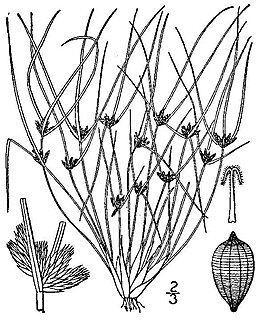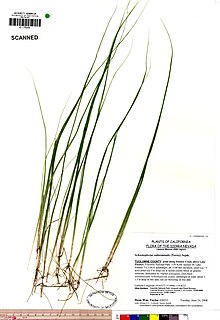
Fimbristylis is a genus of sedges. A plant in this genus may be known commonly as a fimbry, fimbristyle, or fringe-rush. There are 200 to 300 species distributed worldwide. Several continents have native species but many species have been introduced to regions where they are not native. Some are considered weeds. These are typical sedges in appearance, with stiff, ridged stems and cone-shaped terminal panicles of spikelets. They are found in wet environments, and are most diverse in tropical and subtropical regions.

Fimbristylis miliacea, the grasslike fimbry or hoorahgrass, is a species of fimbry that probably originated in coastal tropical Asia but has since spread to most continents as an introduced species. It is a widespread weed in some areas and is sometimes problematic in rice paddies.

Bromus madritensis is a species of brome grass known by the common name compact brome. The specific epithet madritensis refers to Madrid, Spain. It has a diploid number of 28.

Bulbostylis capillaris is a species of sedge known by the common names densetuft hairsedge and threadleaf beakseed. It is native to much of North America, South America and the West Indies from Canada to Bolivia.
Eleocharis bolanderi is a species of spikesedge known by the common name Bolander's spikerush. It is native to the western United States from Colorado west to Oregon and California. It grows in wet spots in several types of habitat, including mountain meadows and springs. It is a rhizomatous perennial herb producing erect, hairless stems 10 to 30 centimeters tall. The narrow, wispy leaves often have purple or reddish speckles and purplish tinting around the bases. The inflorescence is an oval-shaped spikelet at the tip of the stem under a centimeter long and made up of several dark brown, sometimes purple-tinged flowers.
Eleocharis montevidensis is a species of spikesedge known by the common name sand spikerush. It is a widespread coastal plant native to the Americas. It grows in moist, sandy spots in many habitat types, including lakes, riverbanks, wet meadows, and springs. It has a disjunct distribution, in North America and South America.

Fimbristylis vahlii is a species of sedge known by the common name Vahl's fimbry. It is native to much of Central America and the southern half of North America, where it grows in wet habitat. This is a small, clumping sedge producing rounded stems just a few centimeters high surrounded by curling, thready leaves. At the top of the stem is an inflorescence which is a cluster of several cylindrical, pointed spikelets surrounded by long, narrow, twisting bracts. The fruit is a tiny achene about half a millimeter wide.

Lipocarpha is a genus of sedges known as halfchaff sedges. There are approximately 35 species and representatives can be found throughout the tropical and warmer temperate areas of Africa, Asia, Australia, North America, South America and various oceanic islands. These mostly are erect annual herbs growing 1 to 30 centimeters tall. The inflorescence consists of one to few spikes each containing many spirally arranged spikelets. The flower is entangled with two hyalin scales, a spikelet prophyll and a glume. These flower stands in the axil of a spikelet-bract.

Fimbristylis ferruginea is a species of fimbry known by the common names rusty sedge and West Indian fimbry. The plant is common along the coast line and estuaries of Australia. It is also native to parts of Africa, southern Asia, and South America. The flowers are a distinctive rusty brown color appearing on a single spikelet from May to July.

Poa napensis is a rare species of grass known by the common name Napa bluegrass. It is endemic to Napa County, California, where it is known from only two occurrences near Calistoga. It grows in moist, mineral-rich soil around hot springs. The rare grass only occurs on private, unprotected land and depends on water from the hot springs; changes to the local water regime or any other aspects of its specific habitat type would affect the plant. This grass was federally listed as an endangered species in 1997, along with another rare local hot spring endemic, the Calistoga popcornflower.
Isolepis carinata is a species of flowering plant in the sedge family known by the common name keeled bulrush. It is native to North America, where it is mostly distributed around the southeastern United States; it can also be found on the California coast. It grows in many types of moist and wet habitat, including disturbed, cultivated, and landscaped areas. It is an annual herb producing clumps of slender, erect stems up to 25 centimeters tall. The inflorescence is a solitary spikelet just a few millimeters long, or a cluster of up to three spikelets. These are accompanied by a stiff bract which looks like an extension of the stem growing past the spikelets.

Scirpus microcarpus is a species of flowering plant in the sedge family known by the common names panicled bulrush, smallfruit bulrush, and barberpole bulrush. It is native to North America, where it can be found throughout the northern and western regions, from Alaska across Canada to the northeastern United States, in most of the central and western states, and in Baja California. It grows in many types of moist and wet habitat. It is a perennial herb growing from a long rhizome system. The erect, three-angled stems often exceed one meter tall. Sheathing leaves occur at the stem bases as well as higher up the stems. The inflorescence is a panicle of many clusters of spikelets and leaflike bracts on long, thin branches. The fruit is a pale, smooth achene less than 2 millimeters long.

Schoenoplectus subterminalis is a species of flowering plant in the sedge family known by the common names water bulrush, water club-rush, and swaying bulrush. It is native to North America, where it is known from many parts of the Canada and the United States. It has been common in the northeastern US and eastern Canada as well as the Great Lakes region, as well as many locations in the mountains of the West, though apparently absent from the Southwest and from most of the Great Plains.

Spartina gracilis is a species of grass known by the common name alkali cordgrass.

Panicum repens is a species of grass known by many common names, including torpedograss, creeping panic, panic rampant, couch panicum, wainaku grass, quack grass, dog-tooth grass, and bullet grass. Its exact native range is obscure. Sources suggest that the grass is native to "Africa and/or Asia", "Europe or Australia", "Eurasia", "Australia", "Europe, Asia, and Africa", or other specific regions, including the Mediterranean, Israel, and Argentina. It is present in many places as an introduced species and often a noxious weed. It has been called "one of the world's worst weeds."

Schizachyrium tenerum is a species of grass known by the common name slender little bluestem, or slender bluestem. It is native to the Americas, where it occurs in North, Central, and South America. In North America it can be found in the southeastern United States and much of Mexico.

Fimbristylis dichotoma, commonly known as forked fimbry or eight day grass, is a sedge of the family Cyperaceae that is native to tropical areas.

Fimbristylis castanea, commonly known as marsh fimbry or saltmarsh fimbristylis, is a perennial sedge of the family Cyperaceae that is native to the United States of America.

Fimbristylis littoralis, commonly known as lesser fimbry or lesser fimbristylis, is a sedge of the family Cyperaceae that is native to many countries in Africa, Asia and Oceania including across much of northern Australia.

Fimbristylis puberula, commonly called hairy fimbry, is a species of flowering plant in the sedge family (Cyperaceae). It is native to North America, where it has a widespread, but patchy, distribution. The largest populations are in the Southeastern Coastal Plain and the eastern Great Plains. Its natural habitat is in prairies, savannas, and glades. It can be found on both basic and acidic soil.

















